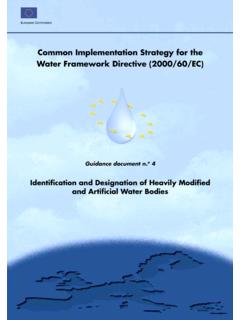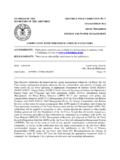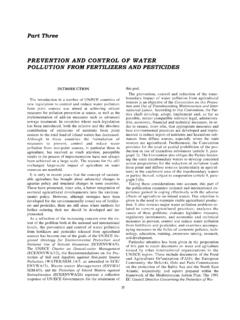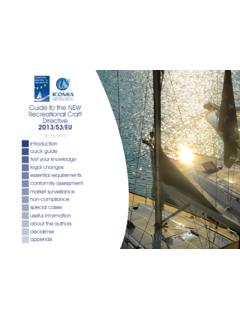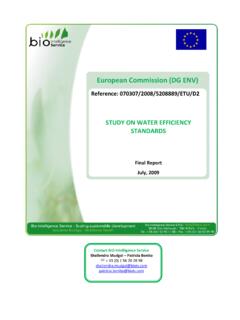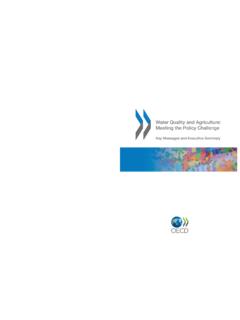Transcription of WATER FOR HEALTH WHO Guidelines for Drinking …
1 WATER FOR HEALTHWHO Guidelines for Drinking - WATER QualityWater safety and human healthThe quality of Drinking - WATER is a powerful environmental determinant of HEALTH . Drinking - WATER quality management has been a key pillar of primary prevention for over one-and-a-half centuries and it continues to be the foundation for the prevention and control of waterborne diseases. WATER is essential for life, but it can and does transmit disease in countries in all continents from the poorest to the wealthiest. The most predominant waterborne disease, diarrhoea, has an estimated annual incidence of billion episodes and causes million deaths every year.
2 There are several variants of the faecal-oral pathway of WATER -borne disease transmission. These include contamination of Drinking - WATER catchments ( by human or animal faeces), WATER within the distribution system ( through leaky pipes or obsolete infrastructure) or of stored household WATER as a result of unhygienic handling. Millions of people are exposed to unsafe levels of chemical contaminants in their Drinking - WATER . This may be linked to a lack of proper management of urban and industrial wastewater or agricultural run-off WATER potentially giving rise to long term exposure to pollutants, which can have a range of serious HEALTH implications.
3 Or it may be linked to naturally-occurring arsenic and fl uoride, which cause cancer and tooth/skeletal damage, Millennium Development Goal target 7c calls for reducing by half the proportion of people without sustainable access to safe Drinking - WATER and basic sanitation by 2015. Reaching this target implies, inter alia, tackling both the quantity (access, scarcity) and quality (safety) dimensions of Drinking - WATER provision. W HO and the Guidelines for Drinking - WATER QualityThe World HEALTH Organization (WHO) was set up in 1948 with the objective of promoting the attainment by all peoples of the highest possible level of HEALTH . WHO has a wide range of functions, which include promoting (in cooperation with other specialized agencies) the improvement of nutrition, housing, sanitation, recreation, economic or working conditions with a bearing on HEALTH and other aspects of environmental hygiene.
4 One of the main roles of WHO is to establish international norms to protect human HEALTH . Since 1958, as part of its activities on Drinking - WATER and HEALTH , the Organization has published at around ten-year intervals several editions of International Standards for Drinking - WATER and subsequently, the Guidelines for Drinking - WATER quality . > 1 The Guidelines for Drinking - WATER quality is one of the longest-standing normative publications of WHO. They provide an evidence-based point of departure for standard setting and regulation as a basis for HEALTH protection. They include an assessment of the HEALTH risks presented by the various microbial, chemical, radiological and physical constituents that may be present in Drinking - WATER .
5 Where applicable, they derive maximum concentration guideline values for these hazardous constituents. In the spirit of primary prevention, the WHO Guidelines recommend pro-active efforts to assess and reduce HEALTH risks. Over the past decades they have evolved from a prescriptive document, which established international standards for end-of-pipe WATER quality , into a normative best practice manual on Drinking - WATER management. Emphasis has shifted to promoting a holistic framework for safe Drinking - WATER , which encompasses fl exible and locally-relevant HEALTH -based targets, a system of integrated risk assessment and incremental risk management from catchment to consumer, called WATER safety plans, and independent monitoring and surveillance.
6 WATER safety plans provide the instrument to make the Guidelines operational. They focus on catchment initiatives for long-term improvements in WATER quality wherever possible rather than expensive treatment options with ongoing costs and large carbon footprints. It is likely that such initiatives will require a longer time for quality improvements to be achieved, but ultimately they will be more effective and sustainable than a treatment-focused approach. Guidelines requirements: A framework for safe Drinking - WATER > 2 HEALTH -based targetsSet by national authorities and based on an evaluation of HEALTH concernsWater safety plansPrepared, implemented, and regularly revised by the WATER supplier comprising.
7 Mapping the WATER supply system ( making a fl ow diagram) Identifying the hazards and assessing the risks from catchment to consumer ( through an agreed ranking system)Implementing needed improvements ( following a prioritized schedule) Monitoring and confi rming adequacy of preventive control measures ( through validation of processes, operational monitoring and end-point verifi cation of WATER quality )Reviewing the WATER safety plan ( through internal audits) and developing supporting processes ( through training) Documenting all of the above, and establishing management and communication procedures for both normal and incident circumstancesIndependent surveillanceUndertaken by the regulator on all aspects of Drinking - WATER safety, including external auditing of the WATER safety plan and verifi cation monitoringPublic HEALTH context and HEALTH outcomeGuidelines, not Standards?
8 In 1982, WHO shifted its focus from International Standards to Guidelines . The main reason for the shift is the advantage provided by the use of a risk-benefi t approach (quantitative or qualitative) to the establishment of national standards and regulations. Specifi cally, the application of the Guidelines to different countries should take account of the sociocultural, environmental and economic circumstances particular to those countries. W ho uses the Guidelines ?The Guidelines are addressed to WATER and HEALTH regulators, policy-makers and their advisors, mainly to assist them in the development of national standards.
9 The Guidelines are also used by many others as a source of information on WATER quality and HEALTH and on effective management approaches. The Guidelines for Drinking - WATER quality are recognized as the UN system s offi cial position on Drinking - WATER quality . The European Commission and Japan use the Guidelines as the scientifi c point of departure for their Drinking - WATER directive and Drinking - WATER quality standards, respectively; the Australian Drinking WATER Guidelines are based on the WHO Guidelines , while the United States Environmental Protection Agency (USEPA) and Canada s HEALTH Canada actively observe and participate in the WHO Guidelines development and updating process.
10 Many developing countries use the Guidelines directly or indirectly in setting national standards. The Guidelines are often used where Guidelines or standards are unavailable and are also referred to in the food standards developed by the Codex Alimentarius Commission (for instance, for mineral WATER and bottled WATER ). Updating the Guidelines The pace of development in WATER supply and in the understanding of WATER and HEALTH has accelerated dramatically. Keeping the Guidelines up to date when information and knowledge are moving so quickly is a major a result, since 1991, WHO has been carrying out an ongoing process of rolling revisions to update the Guidelines .










